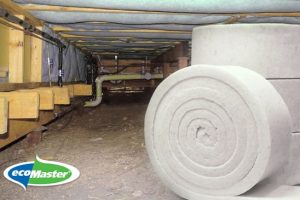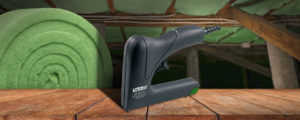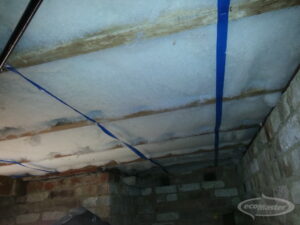Without underfloor insulation the temperature on the surface of your floor will be close to the temperature under your floor. Insulation makes the temperature on the surface of your floor the same as the inside temperature of your home. In a nutshell, it comes down to affordable comfort.
A home without underfloor insulation can be cold and very draughty. Homes that have been re-stumped will often be particularly cold as the tongues in between the floorboards have been broken in order to access the underfloor. Once the floorboards have been reinstated, they will have gaps that allow the cold winter air and hot summer air to flow into your home. We have heard from a home-owner whose rugs ‘levitated’ down a hallway because of the updraught of air from underneath the home!
Reasons to Insulate
Apart from comfort, there are several other reasons for installing effective underfloor insulation:
- The Building Code of Australia now requires underfloor insulation to be installed underneath timber floors in order to achieve the required energy rating for new homes.
- A thoroughly insulated home will be more thermally efficient – meaning it will be warmer in the winter and cooler in the summer.
- Your home will retain its ‘conditioned air’ for much longer, meaning that your heating and cooling systems will achieve the set temperature
much sooner and will maintain that temperature for much longer. - Retained conditioned air translates directly to lower energy bills – around 20% lower. However, that does not take into account the fact that you are also more likely to turn down the thermostat because you will feel much more comfortable.
- Gas heated homes will experience quite a big jump in heating costs this winter due to the world gas parity pricing issues being experienced.
- Any home owner looking to get off grid definitely needs to ensure they have minimised heat flow through the building elements.
- Your home will be much quieter with underfloor insulation in place.
New or Existing
If you are building a new home you will have slightly more choices than if you are retrofitting an existing home. With a new build, you may select a product that can be easily fitted from above, before the floorboards are installed. With existing homes, your product choices will be limited to more flexible products that can fit through an access point, bend around corners, fit over or under plumbing or gas lines, etc.
Selecting Insulation
Given that underfloor insulation is relatively new to the building scene, many builders do not have a good handle on the best way to achieve an effective, long-lasting result.
When selecting an underfloor material the main things to consider are:
- Effectiveness – is the product going to deliver the insulation value promised?
- Longevity – is the material going to last and will it still be held in place in years to come?
- Resistance – is it resistant to rodents and will it deter rodents, not
encourage them?
The many types of insulation available for under floors include: sarking draped over the joists, pleated foil batts, foilfaced styrene boards, fibreglass batts, flexible reflective rolls, thick high density extruded polystyrene boards, spray foam, styrene batts, and polyester rolls/batts.
These products fall into one of two overall categories: reflective or bulk insulation. Reflective insulation must work in conjunction with a still air layer between the insulation and the floor. Bulk insulation must work by being held firmly in contact with the floor to the exclusion of all gaps. In practice, there are issues with achieving both of these.
Reflective Insulation
Most reflective insulation leaves plenty of room for rodent playgrounds between the reflective insulation and the floorboards. This is because it is generally fixed to the underside of the floor joists. Even when draped over the joists prior to the floor being fixed down, it can be easily compromised by rodents (eaten through) trying to gain access to warmer areas. This is a major consideration when using reflective insulation. Extracting the corpses of dead rats from underneath a floor generally does not rate highly on most peoples’ bucket list!
Pleated style foil batts are easily drawn perfectly level in a diagram. However, in reality, gravity means these will always sag and it is impossible to lap them in even a vaguely airtight manner. Their effectiveness may, therefore, be considerably compromised. This is basically a paper product that is stapled in place.
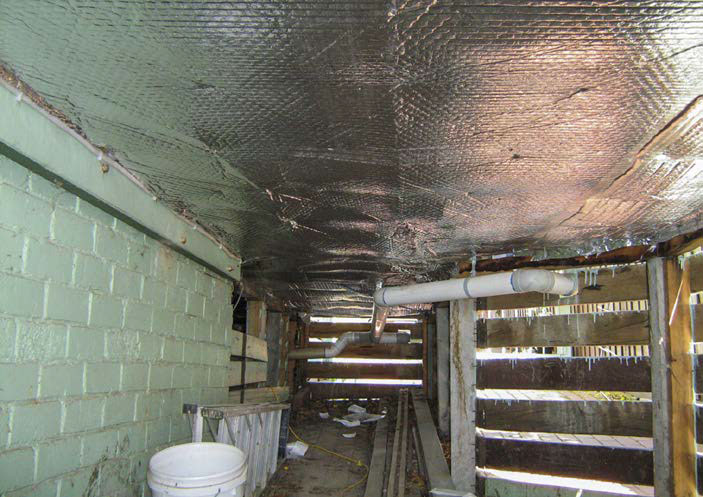
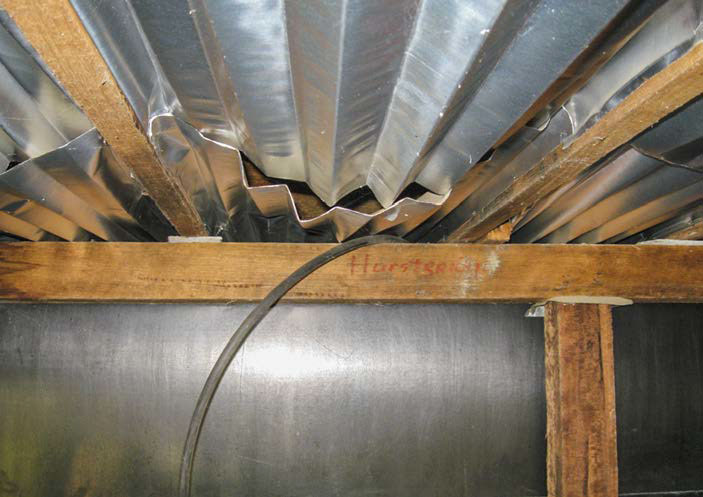
There is a wide range of reflective materials in roll format. In our experience, when stapling thinner varieties of these in place from underneath as a retrofit, the material is so soft that the staples are stronger than the material, pulling tufts of material away from the roll. However, some are much tougher and therefore perfect for stapling in place.
Whenever working with reflective material, take extreme care with electrical wiring. It is very common to have electrical wiring under the floor and once you lift a large section of material up you have immediately lost sight of the electrical cables. Feel carefully to ensure you are stapling ONLY into the timber. Always use a double insulated stapler to prevent electrocution.
Bulk Insulation
Spray foam can be effective where there is sufficient clearance and you have access to a contractor who can install this for you. This is a viable retrofit option. Most spray foams are closed cell, this means that they are impervious to moisture. As a result, any moisture absorbed into the floorboards from above (overflowing bath/dishwasher/washing
machine) would have to evaporate as it cannot be absorbed through the foam. Another thing to consider is that this form of application buries all the wiring and coats all the underfloor pipework. On the plus side, it provides perfect draught proofing for your floor.
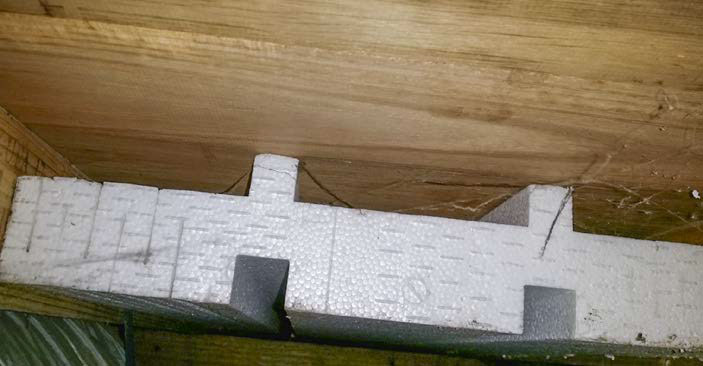
Styrene batts can be easy to fit in a retrofit situation but you will want to secure them with fixings to prevent them from falling out over time; re-fixing may prove more difficult than the initial fitting. Instructions that show a floor that you can stand under during installation are generally targeted at new builds with plenty of floor clearance; retrofitting to homes with minimal headroom and a lifetime of ‘history’ is another matter.
Board Products
Board products have two key issues: challenges with installation and the creation of rodent runways.
Fitting sheet material under an existing floor brings with it many unnecessary challenges. For new build homes, boards with fitting saddles that fit over the joists to hold them in place work well. This is a particularly good system provided that you make sure the fitting is completely airtight, which can be difficult around plumbing and electrical. Compromising a section may create a rodent super highway.
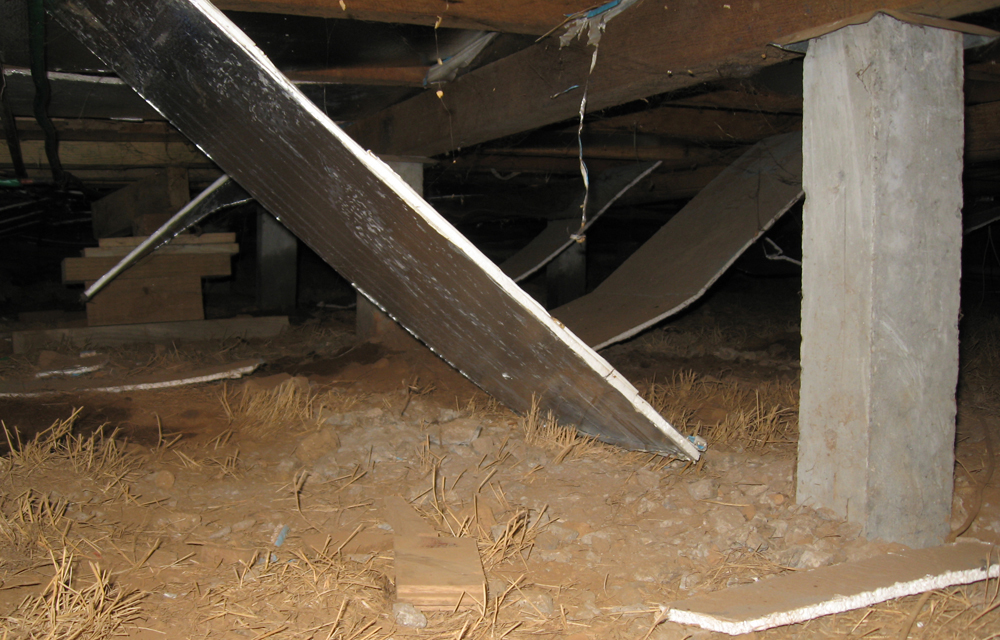
From a retrofit point of view, we have seen quite a few board applications where sections have fallen to the ground; as it is quite difficult to securely fix this type of product while laying on your back on the ground.
Glass Fibre Batts
One of the more popular insulation products for ceilings and walls is glass fibre batts. It is relatively cheap and quick to install in ceilings. Underneath a floor however, its small itchy glass fibres are highly problematic for those who are installing them. The most common fixing method for these is to strap them up using packing strap or fishing line. No amount of packing strap is ever adequate to stop the batts from flopping down.
We have also seen chicken wire and rural fencing used to hold batts in place.


The reality is that none of these methods holds these batts firmly against the floor, which allows gaps for air infiltration. Rodents find these products
particularly appealing and take them away for nesting material. The result
of underfloor glass fibre installation is particularly itchy and irritated installers and sub-optimal performance as chunks of batts disappear over time.
Polyester Batts
Polyester has the major advantage that it is unattractive to rodents. Additionally, a particular variety of polyester is manufactured in such a way as to align the fibres uni-directionally and this makes it super tough and suitable for stapling in place. Stapling is the best way to ensure the product is held firmly against the floor in the long term.
Beware though, as not all polyester is equal. Some are made with randomly arranged fibres, which makes it very soft. While this is fine for ceiling insulation it does not lend itself to stapling underfloor, as tufts of the product will simply pull away from the batt.
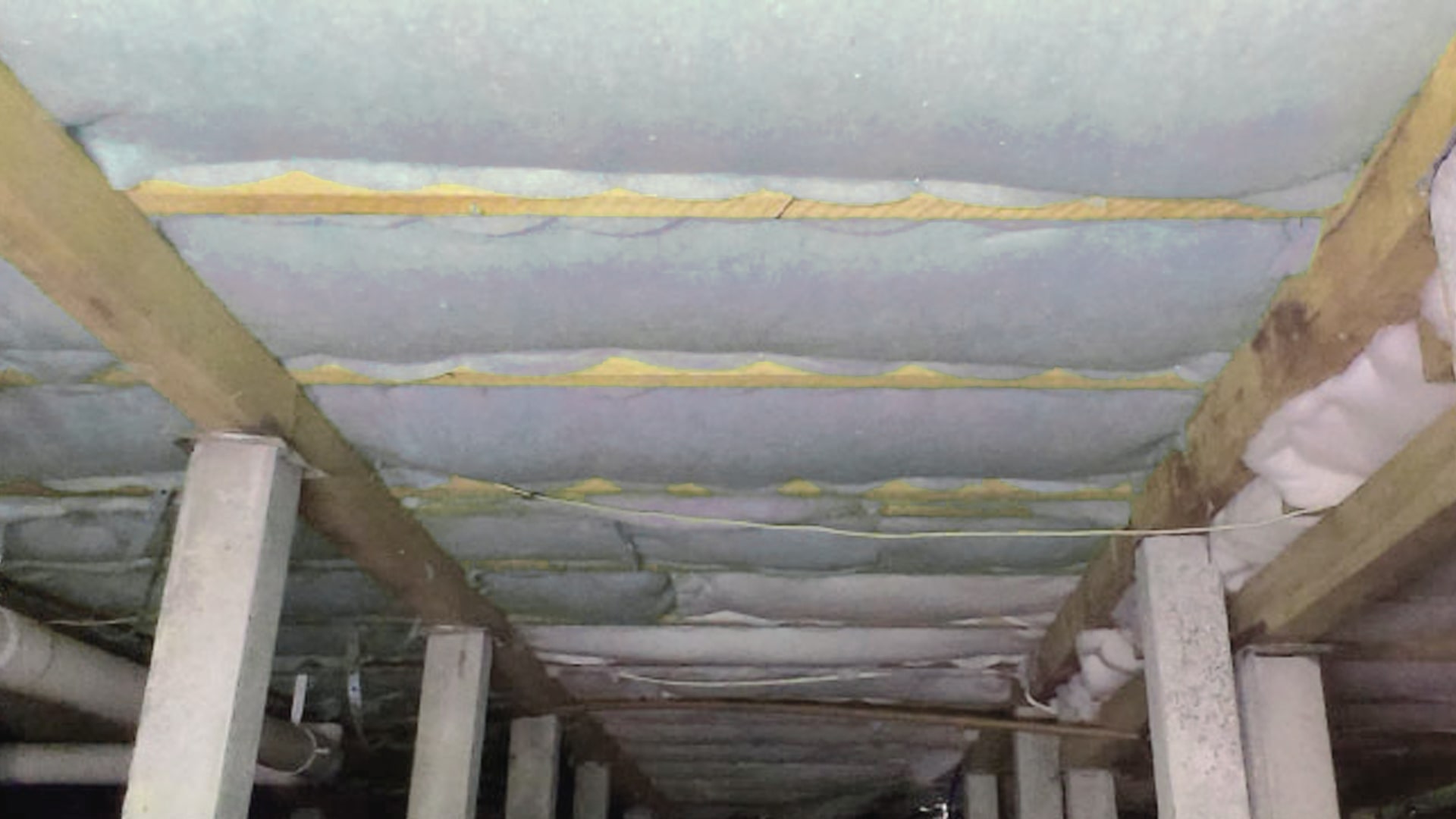
Having the fibres aligned is great for stapling. Having the material made 450mm wide (20mm wider than the standard joist spacing) is even better because now you have extra material to pinch and staple to the lower edge
of the joist. If that same material is also available in long rolls, you have a product that can be easily fitted from underneath or from above. Combined with a rating of R2.5 you have an underfloor material for all climates!
A correctly installed R2.5 rated uni-directional fibre polyester underfloor example. Stapled firmly in place and made using recycled PET bottles, which can then also be recycled!
There is much concern over the creation of waste in our society, so a product that actually converts a waste product into a highly useful product is an added bonus. Recycled milk bottles/PET bottles are the raw materials that make polyester insulation.
QUICK TIP: Ensure that your polyester insulation has not been vacuum packed. Vacuum packing saves on delivery space and costs but does impact the loft (thickness) of the product; the higher the loft, the more effective the product.
Wish List
In order for you to decide which product will work best in your home, you need your own wish list of product features to check:
- Lifespan of product – a product that is long lasting will be better than a short lived product.
- Moisture retention – does not hold moisture/mould/mildew.
- Fire resistance – how does it handle fire or flame?
- Draught proofing – it should prevent draughts coming up through the floor.
- Stability – will it maintains its form/ loft for the lifetime of your home
- Vermin resistant – it does not create a haven for rodents to nest.
- Sealing – can it be installed without leaving gaps?
- Safe – made of non-allergenic material that is safe for your household.
- Eco-friendly – who wants toxic material installed in their home?
The part that adds significantly to the final cost is the installation. Professional installation is much more expensive than the material itself. This is where you can save, by installing it yourself.
Address your thermal comfort issues right away
If you would like an obligation free quotation on underfloor insulation for your home – DIY or installed, go to www.UnderfloorInsulationAustralia.com.au/getpricing
By retrofitting existing homes, comfortable, low carbon living is highly achievable. Call us now on 1300 326 627!

